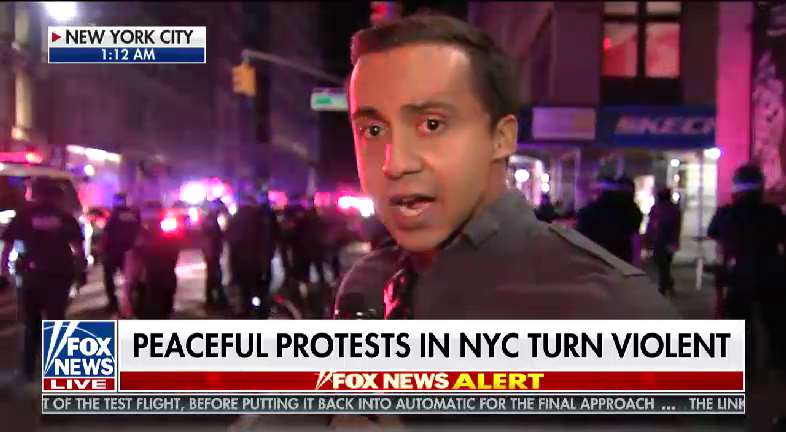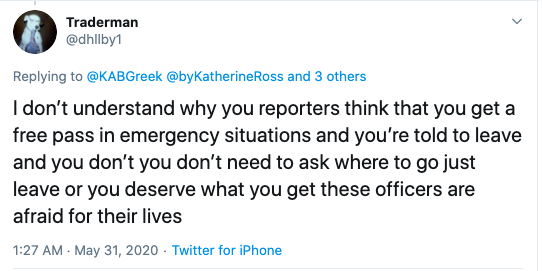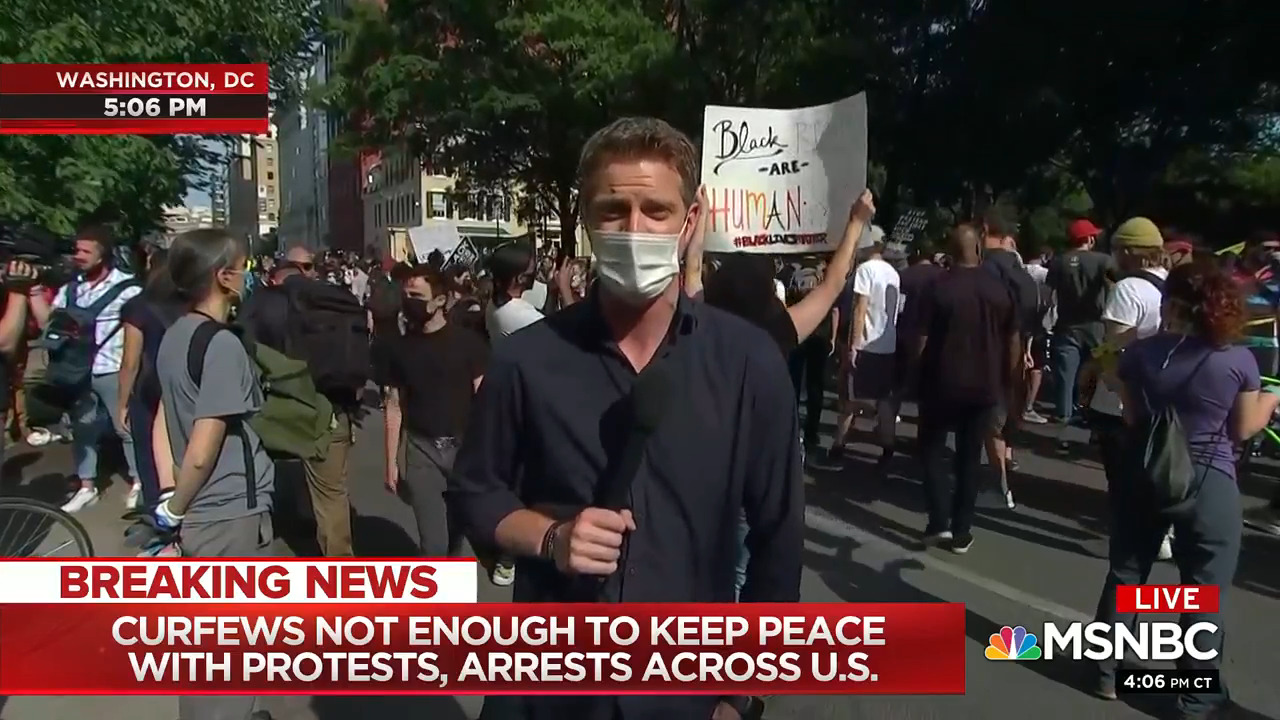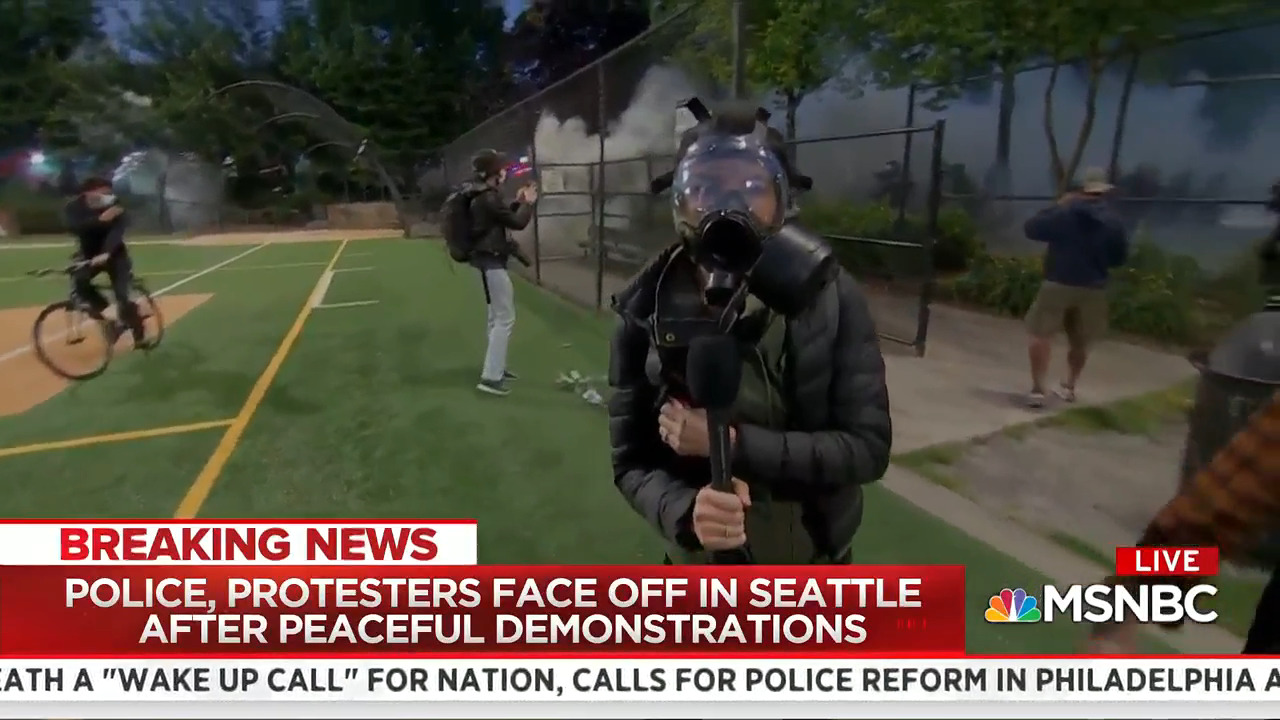On Saturday night, I was home, like most of America, watching the George Floyd protests escalate further in dozens of cities both on TV and on social media.
And then I noticed something: My Twitter feed, which is full of journalists from across the country, was starting to fill up with videos and posts of them being targeted by police. Friday night saw several reports of attacks on journalists by protesters but the police attacks were new — and there were a lot of them.
I couldn’t believe it. I still can’t. I was desperate to do something to help my fellow reporters so I started documenting these incidents in a Twitter thread. It blew up, with nearly half a million views in 48 hours. I have fewer than 6,000 followers on my Twitter account.
I’m a 3rd gen journalist. I follow many journalists on Twitter from all over the country. This is a running tab of incidents I’ve seen of police acting aggressively towards newsgathering teams covering #blacklivesmatter #protests nationwide. CC @Poynter @atompkins @TomWJones
— Katy Byron (@KABGreek) May 31, 2020
Many of the replies on this thread were expected, comments like, “Jesus this thread is shocking. Reporters being attacked all over the US while trying to do their job. I know we can be an insular, self-important bunch at times but this is just wrong,” from Twitter user @markjsobrien.
Or, “America is broken. This thread on the number of journalists injured by US police in the course of their job, which involves reporting and recording the news, is truly shocking. #JournalismIsNotACrime #BlackLivesMatter,” from Twitter user @ItaOKelly.
Or simply, from Twitter user @ellie_harries, “This is awful.”
But there were some other comments that gave me pause. Several users seemed not to understand why journalists — and that includes TV, radio and print/digital reporters, producers, camera crews, photographers, etc. — would put themselves in dangerous situations, and why they were there in the first place.
So I want to lay out some answers to some of these questions in the hopes it adds some transparency and insight into what we, journalists, do and why. One of the classic reporting adages is “report the story, don’t become the story.” And while I agree with this goal, that has also left a gaping hole in sharing with the public the process of good journalism and newsgathering.
So let’s start with a very basic question — why do journalists cover protests?
The short answer: to document the events as a third party, for historic record in times like these, and also to share that information with those who are not present and witnessing events firsthand.
NBC News correspondent Jo Ling Kent is on the ground in Seattle covering the protests there and shared her perspective on this.
“Being there interviewing demonstrators, police and residents allows us to accurately document this historic moment,” she said in an email to Poynter, “so our viewers and readers can better understand for themselves why millions are calling for reform and change right now.”

Fox News national correspondent Bryan Llenas covers protests in NYC on June 1.
Covering protests in New York City, Fox News national correspondent Bryan Llenas shared his views via email.
“Journalism is a public service and I can’t think of a more important place for journalists to be than at protests,” he said. “In a democracy, the right to protest against your government is just as sacred as the right to a free press.”
“I take great pride in trying to bring our viewers an objective and unfiltered view inside these protests,” he added. “Protests are the ultimate test for a democracy. We need to be there not only to ensure that people’s rights to protest are not being violated but also that the message from demonstrators is being communicated accurately to the public at large.”
Something else to think about: After a protest, if you asked the police protesters what happened, you would probably get two different answers.
“Protests are also volatile — highly emotional places — and things can spiral out of control quickly, particularly between police and demonstrators. We need to have our cameras rolling not only to ensure a historical record but also to hold people accountable for their actions during a protest,” Llenas said. “Sometimes there is inappropriate aggressive police action against protesters other times there are violent acts toward police — either way our presence ensures that people are held accountable.”

Fox News correspondent Kevin Corke reports live from protests at Lafayette Park in Washington, D.C.
Another Fox News correspondent, Kevin Corke, has been covering the historic protests in Washington, D.C.
“I believe that the rough draft of history is chronicled in real time by an open and free press,” he said via email. “We are here to document the crucible of the moment … which in my view, makes covering protests incredibly valuable both for those on-scene and for those who might later be fed a narrative that’s inconsistent with the facts as seen.”
Journalists cover these events to provide an unbiased perspective — to show the facts and include evidence. That could mean taking videos from many different angles of the event (that’s why you see camera crews walking around so much) and getting quotes from many different protesters and others present to help tell their story.
“The closer you are to the front lines the more you can understand why it is that people are protesting. The signs; the chants; the size and makeup of the demonstration; how they are protesting matters and I take great pride in reporting from the front lines in the hopes that it can bring greater understanding of the truth,” Llenas wrote.
You might be thinking now, “Hey, wait a minute, you don’t often see quotes or TV soundbites from regular cops at these protests. That doesn’t seem very balanced.” There’s a reason for that.
Every reporter I know early in their career (me included) has probably asked a police officer on scene for a quote or to speak on camera about what is happening during a protest. They always say no because they are not authorized to speak to the media. This is nearly universal police procedure.
Typically, only police chiefs and public information officers speak to the press. If police officers on the scene gave quotes to the press at a protest, they would face discipline. That’s why you often see quotes from formal press conferences or written statements from public information officers, or even sound bites from police chiefs on the scene.

(Screenshot, Twitter)
One Twitter user named @dhllby1 asked, “I don’t understand why you reporters think that you get a free pass in emergency situations and you’re told to leave and you don’t you don’t need to ask where to go just leave or you deserve what you get these officers are afraid for their lives”.
A lot of users piped in on this Tweet and referenced the First Amendment in defense of the freedom of the press. I thank them for that, but there are a few other factors to consider.
When situations really escalate and there is serious danger, journalists will leave any scene, whether it’s a war zone, protest, you name it.
“Who says we get a free pass? When told to leave, we leave. Even when law enforcement is wrong (journalists are exempted from the curfew in Minneapolis) I don’t fight the cops,” Fox News correspondent Mike Tobin emailed from Minneapolis, where he’s been reporting since May 27.

Fox News correspondent Mike Tobin reports from protests in Minneapolis.
But sometimes it’s important to hang back and document what is happening, even if it’s risky, because those heated moments are when things can really go awry — and you want a third party reporting how it all goes down.
For example, let’s say someone gets hurt — a protester or police officer. A journalist can record or report how that happened.
Al Tompkins, broadcast and online senior faculty at Poynter, and probably the most experienced journalism teacher in America, also replied on the Twitter thread, writing, “Journalists report awful and lawful demonstrations, lawful and unlawful policing. That witnessing and documenting is the best protection both sides have against accusations of excess. Reporting is the enemy of brutality and thuggery.”
“Eyewitness reporting is still not 100% accurate, but it is the most accurate type of reporting that exists,” Tobin wrote. “When police evacuated the 3rd precinct and the mob took over the building, I reported from a very confident platform having witnessed all that in real time. I was not relying on sources who said the 3rd precinct had been ceded to the mob.”
NBC News’ Kent was hit by a flash-bang grenade live on MSNBC on Monday night reporting from Seattle. Her team quickly fled the scene to safety. She told Poynter, “Telling these kinds of stories is why I became a journalist in the first place. And yes, sometimes escalations happen and our first priority is always safety.”
Mainstream media get accused of partisan reporting, all day, every day. But there are thousands of reporters who strive all day, every day to provide neutral, nonpartisan and unbiased reporting and take that responsibility very seriously. It’s usually the cable TV primetime anchors, columnists, opinion and commentary writers, talk radio and political contributors that fuel that public perception — not the work of the field teams on the ground doing the oftentimes very hard job of newsgathering.
“There is a unique relationship between the public and the press with this experiment of independent, free journalism. That creates a tremendous responsibility for those of us who have the privilege of doing this job,” Tobin said in an email.
He added that there is a great deal of misinformation.
“It is generated by the internet, by the demonstrators and we have seen misinformation generated by police,” he said. “Particularly in these times, someone needs to show up and provide the public an accurate record from which people can generate their opinions.”
There are many reporting teams covering these violent protests who fear for their safety. Many have never covered violent stories like these and have no formal training. Most do not have the experience of a veteran field reporter like Tobin, who has covered five wars around the world.
“I’ve been in situations of greater risk than this,” Tobin said. “I’m more concerned of getting caught up in a big embarrassing event that becomes a distraction from the story.”
He added that “many journalists over many years have taken great risk to get their stories into the daylight or to set the record straight. Many have paid the ultimate price. The risk we encounter in demonstrations is small by comparison.”
Fox News’ Corke echoed this sentiment, saying, “As for emergency situations and journalists, the mindset for me is, we are here to document American life as it happens and to coexist with emergency officials without interference from either side.”
“If we cede the power to shine the light of truth,” he added, “we will have given away freely what so many have sacrificed and paid a heavy price for.”

MSNBC correspondent Garrett Haake reports from protests in Washington, D.C.
MSNBC Correspondent Garrett Haake, who is based in Washington, D.C, has been reporting on the protests there this week. He shared his thoughts over email.
“These aren’t just our viewers, they’re our neighbors,” Haake said. “Reflecting what they feel is especially important. If they can put themselves in harm’s way, so to speak, I think I can do the same to listen and tell their story.”
Each newsgathering team on the ground has families and friends to care for and they do this work because, usually, they care deeply about bringing you the facts.
“It is extraordinarily difficult to be a reporter in 2020,” Llenas wrote “ … News is moving at warp speed, and it can be physically and emotionally draining to keep up with it all. The hours are impossible, your days are unpredictable, people generally dislike the press, but man, I absolutely love this job.”
Katy Byron is the editor and program manager of Poynter’s MediaWise, a nonprofit project teaching millions of Americans how to sort fact from fiction online. Reach her at kbyron@poynter.org.







